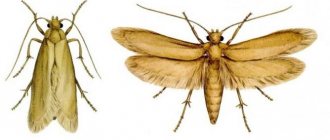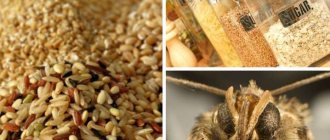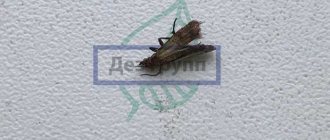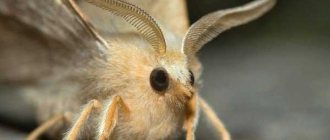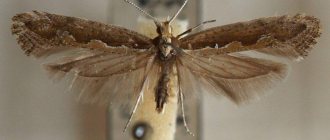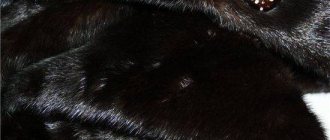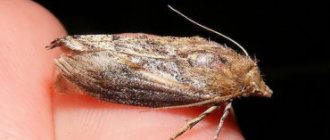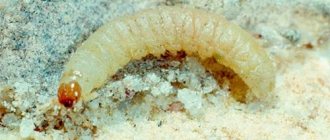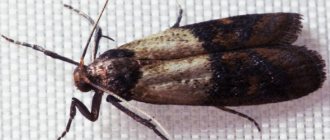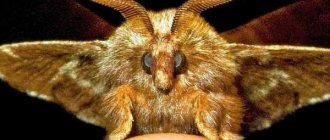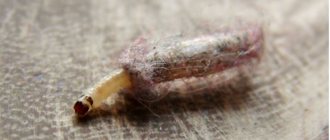Moth control products?
A wide range of products that answer the question of how to get rid of moths in the kitchen is divided into several groups:
- Aerosol insecticides. They help get rid of the problem in one day, but some of them are expensive or have an unpleasant odor. In addition, you must use personal protective equipment, but if you are prone to allergies, there is still a risk of getting poisoned
- Fumigators. They help to slowly but surely destroy moths indoors. Like aerosol agents, this type of poison allows you to destroy, in addition to moths, other unpleasant insects, including flies and mosquitoes.
- Special sections. Their effect is mainly to repel insects and if the room is significantly infested with them, the problem cannot be solved.
- Traps and adhesive tapes. They allow you to get rid of adult moths, but they do not harm the larvae. These products are a good additional tool in the fight against insects and are completely safe for people.
- Folk remedies. Most of them allow you to scare away or destroy moths, but you need to choose the right product and use it wisely.
What are they afraid of?
Here it must immediately be said that an adult moth butterfly and its caterpillar are two different creatures, and their perception of certain factors as a threat to life is very different.
Aromaprophylaxis
It is much easier to fight a butterfly, and even easier to prevent its appearance in the house. To achieve this, many proven folk methods have been used very successfully for many decades, most of which are based on repelling insects with unpleasant odors.
We list all the main sources of such aromas that repel these pests.
These include the following:
- citrus fruit peel;
- laundry soap;
- vinegar;
- geranium flowerpots;
- tansy and wormwood inflorescences;
- dried lavender or its oils;
- fragrant tobacco;
- garlic cloves
Among these remedies, we note the excellent preventive effect of laundry soap, as well as the smell of garlic. These products are available to everyone, and perfectly perform their repellent function against adult insects.
And lavender, by the way, is even used as a flavoring agent in the creation of special chemical moth repellents.
Sunlight and high temperature
If aromatic protection, by and large, helps well in repelling adult insect pests, then intolerance to light and sunlight has an equally detrimental effect on both butterflies and moth larvae.
As a preventive measure, and simply when fighting pest larvae already found in an apartment, an excellent way to get rid of them is by airing and frying items of clothing, for example, in the sun in hot weather. Even after hanging a fur coat at less than 30 degrees, most caterpillars die in the sun's rays or are easily blown away by the wind.
Also a good way to destroy insect larvae and eggs is to wash items at the maximum permissible water temperature. If we are talking about furniture or carpet, you can use a technical hair dryer to blow hot air.
In general, temperature can be considered our ally in the fight against these pests. At a temperature of 45-50 degrees, the moth will certainly die, including adults, larvae and eggs.
Frost and cold are our friends
Are moths afraid of frost? Don't even doubt it. This insect fears sub-zero temperatures even more than light and heat. Already when the ambient temperature drops to 10, the insect feels very uncomfortable. The rate of development of larvae and maturation of pupae slows down significantly, while adult butterflies begin to look for more favorable conditions for laying eggs.
When the thermometer stops at zero, insects and their larvae usually die, or, in the best case for them, are on the verge. If the room temperature is minus, this is already a death sentence for insects of all types and their caterpillars.
Chemical weapons against pests
The most reliable method of influencing this pest would be, of course, the use of chemical agents to kill moths and other indoor insects.
These include all kinds of sprays and aerosols, as well as evaporative insecticides.
Let's start with the last ones. Fumigators have proven themselves to be excellent repellers and destroyers of flying insects such as mosquitoes, flies and moths.
The principle of operation of such products is to evaporate special plates or liquids using heat.
Thus, the insecticide they contain either kills insects indoors or forces them to look for a fifth corner.
Among such evaporators, the well-known fumigators and Raptor plates perform well.
This manufacturer is an absolute leader in the field of creating means of protection and control of insects in the vastness of the CIS countries.
If we talk about spray sprays, there are also a number of recognized options that have good reviews from users, including the following:
- Antimol;
- Armol;
- Raptor “Protection from moths”;
- Dichlorvos NEO or BUNTOKS;
- Moskital “Protection against moths”;
- "Clean house".
In a word, there is a choice. All of these products serve their purpose equally well; the difference may be in price and degree of harm to humans and pets. This is definitely the most compelling answer to the appearance of moths in the house, be it butterflies or even their larvae.
However, not everyone wants to use insecticide spraying in the kitchen, even if in the specifications of some aerosols manufacturers assure that the product is completely safe for humans. Still, you need to understand that getting a toxic substance into food or on the dinner table is not good.
Therefore, let us once again recall the preference of fighting food moths in the kitchen using preventive methods and evaporative fumigators. In any case, make your own decision here and at your own risk.
OUR READERS RECOMMEND!
To get rid of insects, our readers recommend the Pest-Reject repeller
. The operation of the device is based on the technology of electromagnetic pulses and ultrasonic waves! Absolutely safe, environmentally friendly product for humans and pets. Read more here...
Differences from other species.
Externally, clothes moths are very similar to furniture moths - until the middle of the last century, they were even considered the same species. Despite such great similarities, these insects still have clear differences from each other. The furniture moth is larger; its wingspan can reach 18 and even 20 mm.
It is also slightly different in color - this butterfly is yellowish in color, while the clothes moth is almost white. The furniture moth's head is most often covered with yellowish-brown rather than reddish-brown hairs.
Photo of furniture moth.
Food moths are the name given to all granary pests belonging to the fire family. It is quite simple to distinguish food moths from clothes moths. These are small butterflies, the wingspan of which usually does not exceed 1 cm. Most species of moths are gray in color, their wings are covered with spots (unlike the wings of clothes moths, which are colored uniformly).
You can see what food moth looks like and learn about it here.
Carnation
Eugenol, which is part of clove oil, is a natural insecticide. It repels moths well and does not allow them to settle in furniture.
There are different ways to use cloves against moths:
- Pour the dry seasoning into a small fabric bag and place it inside the cabinet.
- A small bouquet of carnations can be hung on a barbell. This type of ikebana will perfectly repel insects.
- Arrange the clove constellations on shelves, or stick them into fresh orange peels: the citrus will enhance the effect of the spice.
Damage
The larval stage of the insect is the destructive stage of the moth's life. Insects feed on the wool of outerwear, carpets and rugs, as well as upholstery of upholstered furniture, furs, animal hair, felt pads in musical instruments and even fishmeal, which is found in abundance in fish food.
Characteristic damage usually appears in hidden places, for example, under collars or cuffs of clothing, in the crevices of upholstered furniture, as well as on carpets, some of which lie under furniture. It is worth noting that fabrics contaminated by food, sweat or urine stains are more susceptible to damage by pests due to their attractive aroma.
What does the modern market offer?
To destroy moths in a closet with clothes, you can use the following drugs:
- fumigation;
- contact.
Fumigators - moth killers
It’s probably worth starting the review of fumigation agents with the “killer weapon” itself - naphthalene. For a long time there was no alternative. It is really effective, but it has already been proven that naphthalene is toxic and unsafe for humans. It and similar, but less harmful drugs are intended for closed spaces. Place the product in your wardrobe, print it out, the active substance will gradually evaporate. The expected effect is repelling insects, as well as their death. The advantage of anti-moth fumigators is their relatively long service life.
Contact anti-moth agents
Contact group preparations are aerosols that are used to treat carpets, cabinet walls, and furniture. They are toxic to one degree or another. Moth larvae, eating the active substance, definitely die. Although, it is worth pointing out another significant drawback - the short time period of effective impact.
Traps for clothes moths
The advantage of these products is the absence of insecticides. A very popular “design”: a layer of adhesive substance located on the inside of the trap + a female pheromone dispenser that attracts butterflies. For humans, this smell is elusive, but adult males, who are attracted to the female pheromone, stick to the glue and die. Thus, the number of insects is sharply reduced, which means the intensity of reproduction decreases. The efficiency of a sticky trap is determined at 10-12 weeks.
Pheromones can be added directly to the adhesive, using adhesive tape as a trap.
By the way, by the number of individuals stuck to the glue, one can judge the scale of the infection. In principle, it can be used all year round. If insects suddenly appear on them, this is a signal for active action.
Bay leaf
A few fresh leaves placed in the closet between things, rugs, blankets will reliably protect them from harmful insects. Dried ones are also suitable - you can prepare a bay infusion:
- take 0.5 liters of water;
- add 4-5 leaves and boil.
Let the product brew and cool. Then soak a cotton swab in it and wipe the walls and shelves of the cabinet.
iarriba
Preventing moths
To prevent the appearance of moths in your home, you should follow simple rules:
- Before storing clothing items in the closet, they should be cleaned or washed. If necessary, use dry cleaning services.
- Winter fur and seasonal woolen clothing are kept in covers in which special moth repellents are placed.
- Wardrobes, upholstered furniture, and carpets are systematically cleaned with a vacuum cleaner.
- Storage areas are periodically washed with detergents and then wiped with table vinegar. Its aroma repels moths.
- The harmful insect cannot tolerate the smell of printing ink, so it is recommended to place crumpled newspaper sheets in shoes for safety.
The moth will not cause any significant harm if the presence of these insects is detected in a timely manner and measures for destruction are taken.
Repair
Often the buttons on a coat become weak over the winter: it is better to immediately strengthen them and sew on the ones that have come off. If a zipper sticks or comes apart, go to a repair shop: they will either repair it or completely replace it. If there are cuts or holes (most often this concerns children's clothing), then the workshop may offer to make a beautiful darning or appliqué in this place.
“If the heels on your winter shoes are worn out, it’s better to get them repaired before you put everything away in the closet. Believe me, when autumn or winter unexpectedly comes again, you will praise yourself for having the foresight to repair everything in advance,” the expert adds.
Question answer
Are salt stains dangerous for shoes?
Some more helpful tips?
Place dry foods that you plan to store for a long time in the freezer for a week. The reason is simple: if you have purchased products contaminated with moth eggs, keeping them in the freezer for a week will kill them, because at the initial stages, moth eggs are invisible to the naked eye and are harmless.
To minimize the risk of dry foods becoming infected with moths, they should be stored in plastic, hermetically sealed containers or hermetically sealed plastic bags.
Please note that it is recommended to use several bags, one on top of the other, and do not use elastic bands or clips to close them.
It is not recommended to purchase dry products in damaged packaging, because in this case the risks of them becoming infected with moths will be maximum. Our employees have extensive experience in combating clothes and kitchen moths and are ready to carry out prompt, safe and affordable treatment of your home!
Our employees have extensive experience in combating clothes and kitchen moths and are ready to carry out prompt, safe and affordable treatment of your home!
We use galoshes
In wet weather, galoshes are required to protect the wool from dirt and excess moisture. If water gets on the products, they are dried. Drying affects shoe sizes. If the temperature is incorrectly selected, they decrease. To protect felt boots, modern manufacturing companies supplement them with rubber soles and inserts made of natural or artificial leather. They can be used in late autumn.
Prevention
There are a number of recommendations that, if you follow, will protect yourself from infection:
- Store bulk products only in tightly closed containers or jars, as parasites can chew through polyethylene.
- When storing warm clothes in the closet, make sure they are clean. Pests are primarily attracted to stale clothes with the smell of sweat or dirt. It is better to store items in cases or bags. Once every couple of months, clothes should be taken out and aired.
- Things that are attractive to pests, such as fur coats and carpets, are best treated with a disinfectant before storage. Such products usually protect things for several months.
- Ventilate and clean the house regularly. Cleanliness and good air circulation are a hostile environment for pests. When cleaning with a vacuum cleaner, carefully vacuum the cracks in the floor, between baseboards and walls, etc. Larvae are often found in such hard-to-reach places.
- Individuals cannot tolerate typographic smells. So you can safely store things wrapped in newspaper sheets.
Cinnamon sticks
Cinnamon is used not only in cooking. The specific smell of the seasoning repels moths and protects things from them.
How to use:
- tie 2-3 cinnamon sticks into a bun;
- hang it on a rod in your closet.
To prevent the tart cinnamon smell from permeating things too much, wrap the sticks in parchment or tissue paper.
Aerosol products against clothes moths?
If you are interested in how to get rid of moths in a closet as quickly as possible, we recommend that you pay attention to aerosol products, which are a solution of an insecticide under pressure in a container. The toxic substance penetrates the respiratory system of the insect with air, as well as through the chitinous cover, causing the death of the moth
Today, such drugs as “Mosquitall”, “Antimol”, “Dezmol”, “Foxide”, “Armol”, “Raptor” and some others are widely used by consumers.
If you decide to fight clothes moths with an aerosol, you must first go through all the clothes in the closets and shake them out. Then all things, furniture and places where pests are likely to accumulate are treated with the drug. After this, the room should be closed and left for several hours, after which the room should be wet cleaned. It is almost impossible to combat food moths with aerosols, since it is impossible to treat products contaminated with insects with the product. However, you can throw away all spoiled food and then treat the furniture with an insecticide.
Indian lilac
This is an anti-moth that nature itself invented. The aroma of lagerstroemia (this is the scientific name of Indian lilac), which people like so much, can drive moths crazy. Hang a few fresh branches of the plant in the corners of the closet and you will forget about the problem.
If it is not possible to find fresh lilac, then make a solution of water and a few drops of essential oil. Dip a cotton swab in the solution and place it inside the furniture. If you can find dry powder, pour it into a fabric bag and place it on shelves, or hang it up like a sachet.
Why does he eat clothes?
Anyone who is faced with the appearance of pests in the house is interested in questions about why and how moths eat clothes. That food is necessary only for pest larvae for growth and development. Imago, that is, adult individuals, do not need food. Over the course of their life, which is about a week, they use up the energy reserves stored in the larval stage.
The nutritional features of moths include the need for protein, which is contained in natural fabrics, feathers, and fur. However, in the absence of their usual food, caterpillars may begin to eat synthetic fibers. Such a diet slows down the formation of the pest, but allows it to receive a sufficient amount of substances necessary for the transition to the next stage.
Kinds
Several main types of moths can live in apartments, namely: clothing moths, furniture moths, and food moths. Each species is characterized by certain external signs and feeding habits. The wool or furniture moth is particularly large in size, often up to two centimeters, and golden in color. Insect larvae feed on wool and fluff.
The clothing or clothes moth prefers various products made from natural fabric; they constitute the main diet of its larvae. Clothes are smaller in size than furniture and have a faded color. Throughout her life, the female lays about one hundred eggs. Clothes moth eggs can be found in the folds of clothing and furniture. The development of the larva to the adult state can last from several months to one and a half years.
Harm from clothes moths
14 species of this insect can be found indoors. It is very difficult to distinguish and understand which species a certain individual belongs to. An adult female lays from 50 to 300 eggs per week, which turn into larvae and then into pupae. And butterflies emerge from the pupae, which we see indoors. They prefer poorly lit places. Depending on the diet and type of parasite, the period of transformation from an egg into a butterfly can be different (40 - 300 days). Usually, the fact that a moth has appeared is recognized by the already flying butterflies. Most often, this means that caterpillars are breeding in things.
Interestingly, the insect itself does not cause harm; caterpillars exclusively feed on your things. The clothes moth caterpillar is capable of digesting a huge range of poorly soluble substances. These can even feed on technical materials, for example: heat-insulating felt, leather, book bindings, fur products and feathers. To find food, caterpillars can chew their way through various materials. They can withstand fasting for quite a long period.
How to fight moths?
What to do if you discover the presence of “such a butterfly” in your home? There are many means to kill the parasite, but using one of them will result in temporary destruction. In order for this insect to disappear for a long period, it is necessary to use several products simultaneously. This is explained by the fact that to bait larvae and moths you need to use different means.
Interesting points
- The moth tries to hide and not show itself. She leads a sedentary lifestyle. She eats felt boots, starting from the top. If the shoes have leather or other inserts, they will remain intact. Carpet beetles, which are often confused with moths, on the contrary, actively bite into the leather base.
- Under natural conditions, moths eat feathers and animal hairs. There are types of parasites that live in the antlers of antelopes. They chew them right out from the inside. It is not surprising that the insect digests felt well.
- The main sign of the presence of a pest is caterpillars and butterflies in the closet or on felt boots. If the shoes are with the moth for a long time, it is unlikely to be saved.
Moths eat felt boots, starting from the top. If the shoes have leather or other inserts, they will remain intact
Food moth and clothes moth: how to distinguish by flight
Moths, which spoil clothes, appear in apartments much more often. It is distinguished by the golden hue of its wings. If the moth is not touched, it reaches a size not exceeding five millimeters. But when it takes off, it is quite clearly visible. However, in no case should clothes moths be confused with those parasites that feed on cereals and other foods.
Food moths are very different from clothes moths. It has a fairly dark color and relatively large sizes. The site of infection can be found relatively quickly. It is worth considering that the moth flies exclusively in the immediate vicinity of its nest and feeding area. Insects can also be distinguished by their flight style. Unlike other species of moths, they fly very strangely. They are characterized by spiral movements, which are the hallmark of food moths.
How they harm
As we said earlier, all the harm to this insect comes precisely from the moth larvae. This applies to almost all varieties without exception. Gluttonous caterpillars are capable of ruining not only your mood with their harmful actions, but also an expensive piece of clothing or furniture, causing a blow to your wallet.
Clothes moths are by far the most dangerous of all types of household pests. The larvae of this butterfly feed on fibers of natural materials, which can be found in expensive items of clothing, such as a fur coat, or in the upholstery of high-quality furniture sets. Carpets, stuffed animals and even books also suffer from the tricks of these pests.
Larvae can also eat synthetic materials, but such nutrition can only be temporary for lack of anything else. Synthetics are more likely to harm the caterpillars, slowing down their development, but this does not make it any easier for us.
Moreover, these voracious creatures can also chew passages for movement in the fibers of a carpet or fur coat, thereby leaving clearly visible lines and bald spots.
The damage caused by food moth larvae is, of course, less destructive in material terms, but more unpleasant in moral terms. These caterpillars consume almost everything they can find in the kitchen.
They do not touch except garlic and hot spices, but the rest is quite suitable for the larvae as a food source.
Life cycle
Females of both species lay an average of 40 to 50 eggs over a 2-3 week period and die once the laying process is complete. Males live longer than females and continue to mate for the remainder of their lives. The eggs hatch within 4 to 10 days, provided environmental conditions are favorable.
In total, clothes moth larvae molt from 5 to 45 times, depending on the temperature in the room and the type of food available. The larval period lasts from 35 days to 2.5 years. It is during this period that the greatest damage from insects is observed.
Moth larvae are shiny white, and their head capsules are dark in color. As they feed, the worm-like insects rotate, simultaneously producing a web in which they gradually envelop themselves. When the larvae are ready to pupate, they crawl away from their food source to find a deeper crevice, crawl into it and the pupation process begins.
Pupation lasts from 8 to 10 days in summer and from 3 to 4 weeks in winter. Heated buildings allow moths to continue to develop during the winter months. Typically, the time for development from egg to egg is four to six months, with an average of two generations per year.
What does it look like
The name “food moth” refers to insect pests belonging to the Moth family. Representatives of different species of the same family differ in appearance, but also have common characteristics:
- small size (the wingspan of the largest species does not exceed 4.5 cm, but in most species this value is about 1 cm);
- pale coloring of wings and body;
- highly sensitive antennae;
- a fleecy border along the edges of the wings;
- large organs of vision.
In our latitudes, the following types of insects can most often be found in an apartment:
- flour moth;
- mill fire;
- southern barn moth.
It is almost impossible for a non-specialist to distinguish between species characterized by small sizes and dimly colored wings. Adults look like small moths with a scaly body and grey-brown patterned wings. They are nocturnal and highly fertile: in good conditions they lay up to 400 eggs.
The larvae are small, smooth-bodied caterpillars of a light yellow color. They live and feed in flour, baked goods, any cereals, pasta, baby powder formulas, nuts, seeds, and dried fruits. It is in these products that adults prefer to lay eggs. The listed products are what the caterpillar eats. As the larva develops, it envelops itself in a cocoon, so thin threads and soft lumps-nests can be seen in spoiled products.
Most often, the sources where the insect comes from are store-bought food products
You should be especially careful when purchasing packaged bulk foods. They may be improperly stored in warehouses and stores, processed and transported incorrectly.
A small insect causes significant harm to humans and renders large volumes of food supplies unusable. Cereals or flour affected by the pest are usually thrown away. If there is little flour, then it can be thoroughly sifted, if there is a small amount of cereal, then it can be sorted out. But it is impossible to clean a large volume of product.
Food moth and clothes moth: how to distinguish
There is no need to worry about whether food moths are eating clothes. The insect feeds exclusively on food. But when food moths appear in the house, you need to carefully check the closets where clothes are stored. The fact is that food moths and clothes moths are friendly neighbors; where one insect appears, there is a high probability that a second one will appear there.
Clothes moths are a more common problem than food moths. Both species are similar in appearance, but they also have different characteristics. An adult clothes moth is a light yellow iridescent insect with a reddish down on its head. Reddish hair also borders the wings, with a span not exceeding 1 cm. Adults become blind and helpless in daylight, so during the day they hide in closets and dark places in the home.
The food moth is smaller than the clothes moth, its body length in a calm state is no more than 0.5 cm. The clothes pest has a longer body. Also, food moths have darker wings, gray-brown in color.
Also read: How to quickly and easily get rid of house moths
Each species lives directly near its food source. Both food and clothes moths are characterized by a special type of flight. The insects flutter their wings and move in a spiral, which makes them different from other nocturnal moths.
The larvae of both species are almost identical in appearance, actively feed and develop, and as they develop, they weave a thread from which they construct a cocoon.
If the moth is food
Dried fruits can be roasted.
In the case of moth infestation of food products, the use of freezing is difficult. If containers with cereals or other food supplies are taken out into the cold, the insects protected by the loose layer will not die, but will go into suspended animation.
On the other hand, it is also not possible to cleanse cereals or flour from moth waste. Therefore, to kill insects, boiling water is poured into cans of food and then the contents are disposed of.
What temperature is enough for washing?
The minimum is 50 degrees. But the more, the more efficient and faster the process will go. It is necessary to look at things and not harm them, because not all fabrics tolerate high temperatures well.
Is it possible to roast cereals and dried fruits?
Yes, for at least 30 minutes at 60 degrees. This way they will not spoil, and the pests will be destroyed.
Why do moths appear in homes and what do the larvae look like?
Like all “domestic” insects, moths settle in a person’s home, since it is warm, there is a lot of affordable tasty food and comfortable nooks for breeding. The insect feeds on ordinary foods, as well as products made from fur and wool. Moth larvae look like white worms with a dark head and six legs. The worms are quite large in size, reaching two centimeters in length. But sometimes it is not immediately possible to notice the insidious “neighbor” in the house.
To avoid the mass spread of moths in an apartment or house, you need to periodically inspect wardrobes (especially with warm winter clothes) and food products.
Description
A moth is a small insect that is classified as a type of butterfly. The larvae of the parasite feed on particles of wool and lint. In addition to the fact that moths can “eat out” holes in clothing, they also leave behind waste products that spoil the fabric. In just a day, a moth larva makes a through hole in a woolen or half-woolen product.
Due to the fact that moth caterpillars can digest other similar substances, the insect can ruin synthetic, silk, cotton products and items made from other fabrics. Moths die mainly from direct sunlight and large amounts of oxygen, that is, in the fresh air. The insect is also “afraid” of frost.
How to get rid of clothes moths
Do some spring cleaning
Moths like to hide in secluded warm corners, so first of all, take everything out of the wardrobe, vacuum every shelf and drawer, and then wipe all internal surfaces with a rag soaked in any detergent.
It also doesn’t hurt to vacuum carpets and hard-to-reach places where dust usually accumulates: behind furniture, in the corners of dresser drawers, behind radiators. Finally, wash all clothes, as well as curtains, bedspreads, blankets and furniture covers.
Freeze your clothes
In winter, you can take your clothes out onto the balcony, and the rest of the time, use the freezer. Moth larvae die at sub-zero temperatures, so put your clothes in bags and put everything that will fit in the freezer.
Take your clothes out into the sun
Bright sunlight affects moth larvae in the same way as frost. For the insects to die, it is enough to keep the clothes in the sun for a couple of hours.
Wash your clothes often
Moths love particles of dried sweat, so do not put anything in a newly disinfected closet that needs to be washed first, especially if it is knitted items.
Store woolen items in covers
As the weather warms up, put your favorite winter sweaters, dresses and scarves in covers or ziplock bags and add moth repellent to each one. Lifehacker will tell you below what best repels moths.
Quarantine for old times
Vintage wardrobe items, inherited from a great-grandmother or bought at a flea market, must first be dry cleaned and only then hung in the closet. Even if at first glance things do not cause suspicion, moth larvae can easily live in the seams.
Don't let your guard down
Check your clothes from time to time, and regularly ventilate rooms and closets. Don't keep things you don't wear: either throw them away or donate them. Moths most often appear on clothes that have not been taken out of the closet for a long time, and almost never on clothes that are worn constantly.
To repel moths, use natural repellents
The most effective natural remedy for moths is lavender. Cloves also work well (not a flower, but a seasoning), but it has a rather strong smell, which will inevitably be absorbed into clothes, and not everyone likes it.
Use aerosols to kill moths
If you are determined to kill moths using chemicals, the most radical and effective way would be to treat contaminated items and storage areas with aerosols containing powerful insecticides. In addition to the usual dichlorvos, products based on permethrin, pyrethrins and pyrethroids are produced.
However, do not forget that many of them are very toxic, which means they are not applicable in all situations and can cause a severe allergic reaction
Before spraying the aerosol, carefully read the instructions on the package, especially the part about safety precautions
Moth repellents in the closet
There are numerous means that can not only scare away, but also destroy the annoying pest. It is worth noting that the range of chemicals that can be used in a wardrobe is much wider than those that could be used in the kitchen.
Many of the drugs are natural, some are chemical-based, but they all have varying degrees of effectiveness. Therefore, before using the product, it is better to know the pros and cons of the product before making a choice. In the right circumstances, any of these approaches can be useful.
Just remember that nothing prevents the development of moths more than keeping your woolen items clean, provided they are stored correctly.
Cedar
Dark-colored red cedar heartwood contains natural essential oils that will kill moth larvae directly on clothing, but this alone will not protect clothing. In addition, few people know that cedar kills only young larvae, and not older individuals before pupation, and especially moth eggs, which are protected by a dense shell. Also, the effect of cedar oil disappears as the smell weakens. You can coat boards, cabinets, chests of drawers and the clothes themselves with cedar oil, but there is no way to know whether the treatment was truly done properly and how long the effect will last.
Therefore, when working with this product, the best option would be to pre-treat the clothing before placing it in a plastic bag. If suddenly there are eggs on the surface of the coat, the larvae will die quickly after hatching, the adult moth will not penetrate the bag, and the beneficial smell of the oil will not evaporate for a long time.
Naphthalene
This remedy is one of the oldest that have been used in the fight against moths, for more than a hundred years. Naphthalene can prevent moth infestations, but its many disadvantages can outweigh its benefits, so it's probably better to do without it.
This product contains chemical insecticides that may be harmful to people, unborn children and pets. Since naphthalene works by releasing a fumigating gas, it must be used in large concentrations rather than a couple of packets per cupboard to be effective.
In addition, before using things treated with mothballs or saturated with its smell, they should first be thoroughly ventilated.
Lavender
Using this plant to repel moth attacks is an old folk trick among housewives around the world. Sachets filled with lavender or bottles of lavender oil hung in closets or tucked inside drawers are said to help protect woolen fabrics. Additionally, lavender will leave a pleasant scent that most people are comfortable with. However, we must remember that lavender is not capable of killing moth eggs or its larvae, so you should make sure that there are no moths in the closet yet, otherwise the lack of effect will cause confusion.
The effect of temperature on moths and their larvae
Cold weather also negatively affects the growth of larvae. At low temperatures, the larvae again decrease in size, return to the cocoon and remain hungry.
The eggs of house and furniture moths are white or light yellow in color, small in size, only half a centimeter. To lay eggs, the female chooses the best clothes and lays several dozen eggs there, so that later the larvae have something to eat. Within 5–6 days at normal temperatures, moth eggs are ready, but at low temperatures the process of egg maturation slows down. At a temperature of 0°C the larvae deteriorate.
Moth butterflies are short-lived. They live mostly for a couple of weeks and do not feed. For moth larvae that eat wool products, free movement through the fabric is difficult. That part of the threads that they do not eat, they simply gnaw, making a path for themselves.
Image and stages of life
These insects are characterized by multi-level metamorphism. That is, during the course of their existence, they go through several stages of their development with a complete change in appearance and internal structure.
There are 4 such stages in total, we list them:
- butterfly;
- egg;
- caterpillar;
- doll
It all starts with an adult insect, which, by the way, does not pose a threat to any of our kitchen supplies, natural indoor utensils, or fur clothing.
The moth butterfly lives extremely short, and its natural purpose is solely to participate in the process of reproduction and preservation of the population of the species. Moreover, the moth does not even have mouthparts for eating; it does not feed at all.
The male insect participates in mating, while the female takes responsibility for laying eggs in a secluded place suitable for the further development of her litter.
The eggs of these pests are not much different from most other insect clutches. These are white oval-shaped rounds, almost invisible to the human eye, with an embryo inside visible under a magnifying glass.
As a rule, moth eggs mature during the working week while maintaining the ambient temperature within 20-25 degrees. When the temperature drops, the ripening period may increase.
After the specified period, barely noticeable moth larvae, reminiscent of former threads, emerge from the eggs. And here we will go into a little more detail. After all, it is these small creatures that are a real disaster for their owners, since caterpillars themselves are a feeding form of insect life.
They are incredibly voracious, and it seems that their whole point is to constantly eat food. This is also indicated by the structure of the oral apparatus of moth larvae, which consists of 2 mandibles, very massive in comparison with the size of the caterpillar itself, capable of gnawing even tissue fibers and solid food products that are quite strong, as for an insect.
After gaining sufficient weight, the fat larva begins to prepare for pupation. She weaves a cocoon around herself, after which she falls into hibernation, during which the last round of metamorphic transformation occurs in the life of the moth with the transformation into a butterfly.
Common moth
This is the most familiar type, which we already started talking about at the beginning of the article. She is the one who is greedy for woolen and fur things. It is worth adding that caterpillars can digest not only keratin, but also industrial felt, feathers, leather, book spines, antique objects, and even dry meat and fish. A variety of objects located in the apartment are subject to attack.
Sensing the proximity of food, insects are able to gnaw through various obstacles made of other materials: synthetics, silk, cotton.
During the life cycle, an individual undergoes 3 stages: egg, caterpillar, pupa, butterfly. We can only observe adult butterflies slowly flying around the house. Life expectancy, starting from the egg stage, reaches 2 months.
Obviously, the main fight needs to be waged not with butterflies, but with their eggs, because it is from them that caterpillars emerge that actively spoil things while getting food. One clutch of a female contains up to a hundred eggs.
A characteristic feature of parasites is their dislike of sunlight, so they try to stay in the shade. In the apartment, secluded dark places become a refuge. The wardrobe is a paradise for moths. It is always dark there and there is something to profit from. This applies to all stages of the individual: females live in dark corners, where they reproduce their offspring, which also like to be in the dark and safe.
If caterpillars are born in a closet with clothes or near another food source, they do not need to change location. They simply stay in some woolen sweater and spend the entire larval stage there, provided with constant food. It is completely impossible to notice their destructive activity if, for example, it is summer and warm clothes are in storage.
Later in the article we will turn to more “highly specialized” species of moths, which differ in appearance and prefer to feed on specific types of materials and products.
The best tablets and plates for moths
Raptor odorless moth pendant
Rating: 4.9
The first line is occupied by a product that guarantees 5 months of cleanliness without the appearance of butterflies and larvae. The innovative composition protects any products made from fur, wool and other types of fabric. It is harmless to humans and has no impact on the environment. The main component is Vaportin. One section is designed to separate a cabinet with a volume of 0.5 cubic meters. m. It can be hung on a bar, or simply placed in drawers with clothes.
The manufacturer has made it easier to use and equipped the plate with an end-of-action indicator. When the time limit expires, the word end appears on it. The product does not leave stains on clothes and has a neutral odor. It copes well with large concentrations of adults and destroys egg laying.
According to reviews, insects do not appear not only within the period guaranteed by the manufacturer, but often further without the use of additional anti-moth drugs. Once again, buyers were not let down, despite the budget price of their products.
Advantages
- plate replacement reminder;
- newest active substance;
- environmental Safety;
- does not damage clothes and textiles;
- ease of use.
Flaws
- not identified.
Anti-moth plate with lavender aroma Armol
Rating: 4.8
The second was a six-month drug. It causes the death of not only butterflies, but also caterpillars and larvae. In a short period of time, you can completely clear your house of insects and save clothes, shoes, hats, and household items from serious damage. The product has a complex effect on moths and skin beetles. The plates are placed in all the drawers where things are stored. They are placed at the top, since the active substance acts in a downward direction.
The drug may come into contact with materials. It leaves no marks and does not destroy fabric fibers. The composition includes components that do not affect human health. The pleasant scent of lavender gives things a scent of freshness and cleanliness. Economical and easy to use. The plates can be moved from place to place as long as their protective properties are maintained.
Buyers noted that this method of control gives good results without the use of additional funds. The presence of the plates indoors does not cause discomfort to household members. All items, including blankets, rugs, yarn and much more, are reliably protected from damage.
Advantages
- destruction at all stages of growth;
- professional quality;
- long duration of action;
- delicate floral scent;
- for all types of materials.
Flaws
- not identified.
Odorless anti-moth plate DR. KLAUS
Rating: 4.7
Third place was given to the long-acting product. It not only destroys insects that are already common indoors, but also repels new individuals. The drug is effective against adult butterflies and larvae. In a short time, you can completely get rid of them and protect your home for up to 6 months. Next, it is recommended to replace the plates.
The product acts on the skin beetle, so you can prevent the destruction of not only textiles and fur products, but also shoes and leather goods. The composition does not affect human health. Household members do not notice the unpleasant odor. The active substance actively destroys moth eggs.
Buyers note that the plates are compact in size, so they can be placed inside shoes, small compartments and cabinet drawers, and in narrow crevices. The budgetary cost of packaging makes the use of an effective product economically profitable. The drug can be used independently, or in case of a large accumulation of pests in combination with an anti-moth aerosol or spray.
Advantages
- long-lasting and effective protection;
- scaring and destruction;
- preservation of all types of fabric and shoes;
- convenient use;
- harmless, odorless composition.
Flaws
- not identified.
Tablets Clean Home protection against moths Antimol Extra flavored
Rating: 4.6
In fourth place are the popular Russian tablets. They reliably protect wool and fur products from pest invasion for up to 6 months. The product destroys adult moths, larvae and egg laying, and also prevents the appearance of new individuals. The drug is made in the form of balls. 2-3 pieces are enough for one section of the wardrobe. They are also laid out in drawers, compartments, bedside tables, and chests of drawers.
The composition of the drug is absolutely safe for people. It does not cause allergic reactions and has a pleasant smell. The active substance is active exclusively against insect pests. It is an alternative to traditional naphthalene, but has a weaker odor and less flammability. The product does not damage wool or fur items when in contact with them. It protects against skin beetles and, thanks to its miniature dimensions, the balls can be placed in shoes of any size.
According to reviews, the drug is highly effective in combating the spread of moths. For six months, its properties do not decrease and you can be sure that your favorite things will remain untouched by pests. The low price makes the purchase economically profitable.
Advantages
- rapid destruction of insects;
- long action;
- fresh, not intense aroma;
- convenient release form;
- budget cost.
Flaws
- not identified.
Use of chemicals
Special chemical preparations can effectively destroy moths:
- It is more convenient to use the insecticide “Dichlorvos” in aerosol form. All items of clothing with traces of moth damage must be treated. Be sure to follow the safety rules specified in the instructions. You can also use other aerosols that can destroy the pest, for example, “Armol”, “Moskitol”, “Raptor”, and also “Taiga”.
- Plates impregnated with insect-destructive preparations: “Doctor Claus”, “Antimol”, etc. effectively fight adults and larvae. They are laid out on the top shelves of cabinets and replaced with new ones every 3-4 months.
- To repel insects, preparations in the form of balls or tablets are used. Place them in places inaccessible to children.
- As a repellent, a special section is used, which is a housing filled with a substance containing a moth repellent. It is equipped with adhesive tape that allows you to attach it to the closet wall, or a hook for hanging it on a dress rod.
What moths are afraid of: repelling methods
One adult moth can lay 150-250 eggs, so it is advisable to prevent its appearance in the house. In addition to purchasing high-quality groceries, installing mosquito nets on windows, and other preventive methods, conditions in the house that are intolerable for the parasite are ensured. Specific smells help with this.
Products from the following categories repel insects:
- dry herbs and spices;
- essential oils;
- live indoor plants;
- fruit particles;
- some technical substances.
Repellents are harmless to humans, their smell does not cause negative sensations in other residents, unlike insect pests.
Spices and plants for moths
Some types of flowers and herbs (green or dried), as well as spices, have an odor that is incompatible with moths being in the house. Due to this property, they are used to repel insects by placing them in places of feeding and possible accumulation. These plant representatives include:
- wormwood (from moths, twigs and leaves are laid out in the closet, among food products, changed every 1-2 weeks);
- lavender (the flowers of the plant have a pleasant aroma for humans, but are intolerant to moths; they are effective for several months without the need to change);
- tansy (flower branches repel moths and other parasites);
- rosemary (we repel moths, but require frequent replacement);
- mint (suitable for protection against clothes moths, has a long-lasting effect);
- dill (in the form of herb or seeds);
- onions and garlic (placed in the kitchen and pantries to prevent food pests);
- red pepper (plant pods are used near cereals, bread products, flour);
- mixtures of chamomile, cloves, valerian, marigold.
Plants without a strong aroma or with a pleasant aroma for humans are placed together with clothes and fabrics. Specific substances are recommended for use in kitchen cabinets.
Twigs, flowers, moth grass are laid out in their natural form or packaged in separate fabric bags. There are special convenient sachets and sections made from natural ingredients on sale.
Essential oil for moths
The listed herbs and plants, some other representatives of the flora are effective against adult moths and their larvae in the form of essential oil. Additional oils used:
- lemon;
- orange;
- lemongrass;
- fir;
- patchouli;
- thyme;
- tea tree.
Extracts are used separately or mixed with each other. The use of essential oils is convenient, they take up less space, and retain their properties for a long time.
For 1 liter of water you need 5-6 drops of the oil composition. The solution is used to wipe the walls of cabinets, dressing rooms, kitchen furniture, and the floor. Pieces of felt, fabric, gauze swabs are dipped into the liquid, and small containers with essential components are placed on the shelves.
Houseplant against moths
Geranium grown at home effectively repels all types of moths. It is recommended to place flowerpots in rooms where food or clothes butterflies can reproduce.
The pest is negatively affected by all parts of the plant. Additionally, individual flower petals or stems are placed under carpets, furniture, between upholstery or clothing.
Another home plant with similar properties is plectranthus (“moth tree”, spur flower). The aromas it produces effectively repel moths.
Fruit peel against moths
The peel of citrus fruits (orange, lemon) is effectively used against moths. It is mainly used against food pests, less often to protect clothing. Parts of the fruit have a pleasant aroma for humans, but require frequent replacement, as they quickly expire.
To protect seasonal natural clothing and winter items, it is recommended to place them in special bags or covers. The peel of an orange or lemon is placed inside the protective devices. Additionally, fabric bags are prepared, which are filled with herbs mixed with citrus peelings.
What moths are afraid of: technical substances and other means
The following items are classified as moth repellents:
- vinegar;
- laundry and some other types of soap;
- synthetic tablets and balls;
- chestnuts;
- ultrasonic repellers.
The latter remedy works only when connected to the network; its use is justified as an additional control measure along with chemical or folk remedies.
A solution of acetic acid is prepared from the product mixed in water (proportion 1:1). The substance is used to prevent the breeding of moths near food. Kitchen furniture is periodically wiped with a cloth soaked in a solution.
Moths do not like the smell of laundry, strawberry, or dust soap. Bars of the product are laid out in places where moths accumulate. An effective method is to periodically wash the floor, furniture and other surfaces in the house with soapy water.
Special anti-moth balls and tablets, common in retail sales, are used to combat moths. Their effect on the larvae is weak. The advantage of the means is compactness and convenience, but compliance with the quantitative measures specified in the instructions is required.
Occasionally, chestnuts are used against moths, the aroma of which is elusive to humans, but unpleasant to insects. Ripe fruits are collected in the fall and laid out among clothes and furniture. It is important to dry the chestnuts because if they are raw they may develop mold.
